How-to Map Lifecycle Components to Branded Product Release
This guide describes the approach for mapping the lifecycle components derived from the technology product releases, to the branded products (800xA, Symphony Plus, etc.). It also covers how to gather the data and share relevant ECCN-related information with the product classification team.
The guide is divided into two main parts:
General information about export control, export control classification, and lifecycle components can be found under Details.
Intended for
3rd-party software owners, 3rd-party software managers, product owners, release owners, and trade compliance officers.
ECCN for product releases
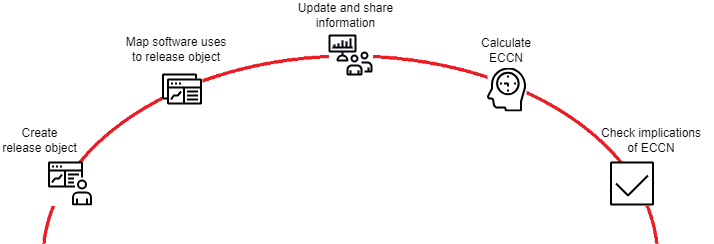
Create release object
The “Provider Full” role (usually the product owner/release owner) shall create the release object according to the following steps:
- Click on the “Add Release” button.
- Fill in the mandatory fields in the new window and submit.
- A release object with its object ID is created.
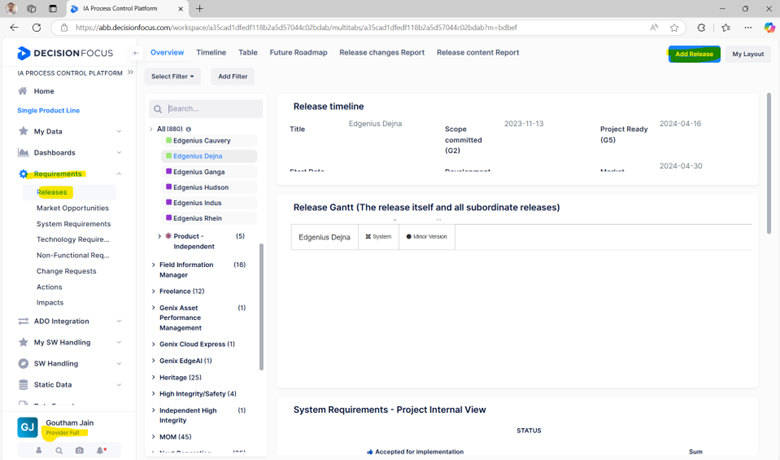
Map software uses to release object
Add software uses to the release object according to How-to Create Software Use in Decision Focus.
Update and share information
When all software uses are mapped to the release from various functional areas, the product manager or release owner shall share the complete extract of the list with the product classification team.
To decide if the release must undergo full or light classification, fill in the 7PAA016324 TPF Decision Flow Template and share it with the product classification team for decision (i.e. the product classification team makes the decision).
Follow the steps in the flowchart below to decide the classification type. If further assistance is needed, send an email to !SE_IA_PCP_PCE.
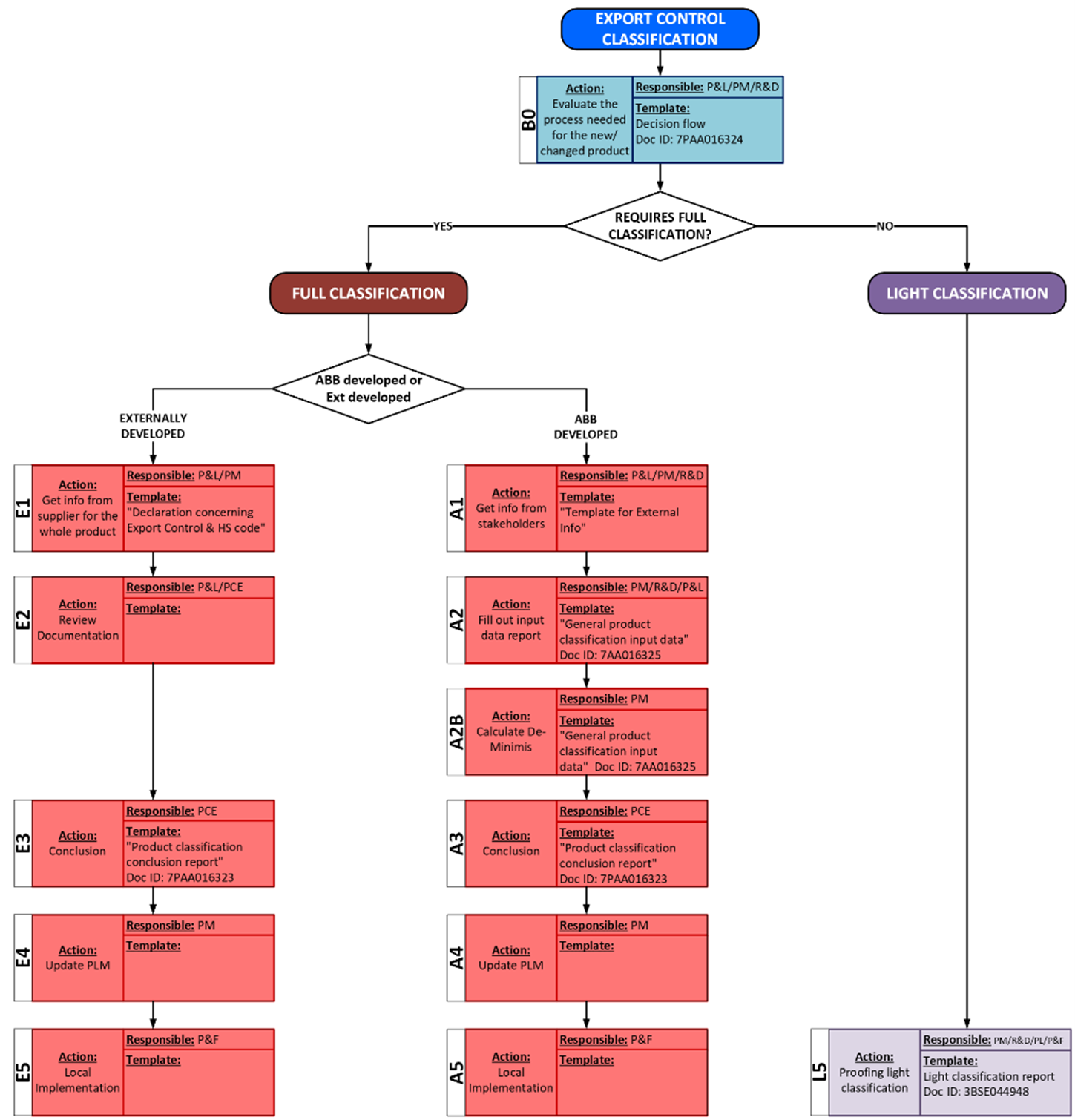
Note: If a branded product release consists of lifecycle components, then the overall software use list (the software use list extracted from Decision Focus) of that system release must also have the technology product release's software use lists extracted from Decision Focus and added as sub sheets in the overall Excel of the system release.
Determine ECCN
The product classification team determines the ECCN for the product based on the steps in the flowchart above. See the Product Classification Overview presentation for more information.
Check implications of ECCN
If the ECCN determination results in a code that has “D00” as its 2nd, 3rd, and 4th characters, then it is a highly export-controlled product that requires export authorization for both external & internal transfers. To obtain such an authorization, contact !SE_IA_PCP_PCE.
Based on the resulting ECCN code, the technology product could be restricted to certain countries and users. Only after analyzing the applicable restrictions, the product will be released for transfer, with proper due diligence.
Failure to adhere to the due diligence steps would lead to high-risk trade compliance issues and could highly affect the release timelines of the technology product.
ECCN for technology product releases and lifecycle components
To map the usage of the lifecycle components with the branded products, the ECCN must be determined for these components from the software use list of the technology product releases from which they are derived, as shown in the block diagram below.
The diagram can also be referred to understand the approach in detail followed by the steps to create a lifecycle component and map its software use, to branded product release.

The process of sharing data to determine ECCN for technology product releases and lifecycle components can be summarized by the activities below, described further in the coming paragraphs.

Note:
- If runtime and development cost components are used (for P&L and P&F purposes), the complete extract of the system release must have all the technology release extract added in the software use list.
- Determining ECCN for a technology product release must be done by the product or release owner of that technology product release by sharing the details with the product classification team.
- These releases may be time-boxed instances (yearly) where multiple deliveries to different systems/products may be worked on.
Create technology product release
Create a release with the same name and version as the lifecycle component. In this guide, the release “Engineering portal 1.0” is used as an example.
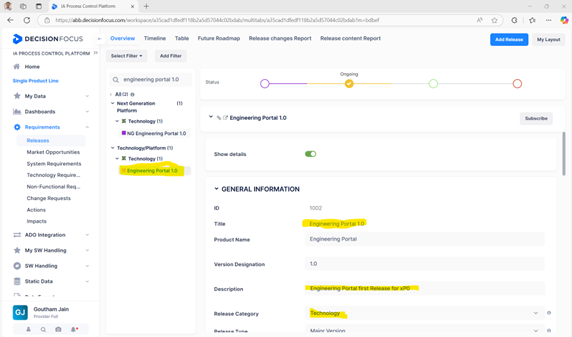
Map software uses to release
Map 3rd party software uses to the release “Engineering portal 1.0” in Decision Focus.
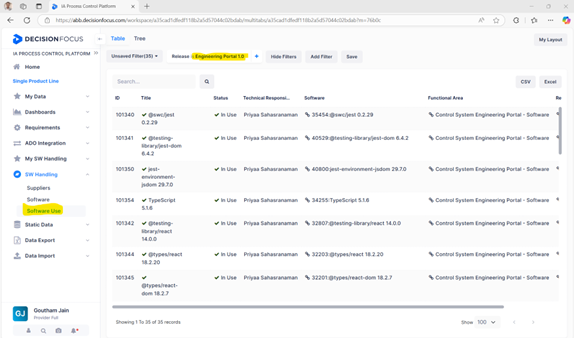
Determine ECCN
Determine the ECCN for the release “Engineering Portal 1.0”, as described in the flowchart under Update and share information.
In general, the release “Engineering Portal 1.0” is the product or lifecycle component that is going to be integrated into the branded product (800xA, S+, etc.). Use the same ECCN for the lifecycle components created in the next step.
Check implications of ECCN
Check the implications of the ECCN for the release, as described in Check implications of ECCN.
Create lifecycle component
Create the lifecycle component according to How-to Create Software in Decision Focus.
Map software use of lifecycle component
The 3rd-party software owner maps the software use of the lifecycle component to the branded product release, see How-to Create Software Use in Decision Focus. Once the mapping is done, the ECCN for the new release should be calculated according to ECCN for product releases.
If the branded product release consists of a lifecycle component(s) in its software use list, then the software use lists of corresponding technology product release(s) (from which the lifecycle component is derived) must also be added as a sub-sheet in the overall branded product software use list.
Details
About export control
Export controls are laws that help governments monitor the types of products, technology, software, and information being exported from a country to support foreign policy and protect national security. Some items are prohibited for export to certain countries, end users, or for certain end uses, or may require an export license or authorization.
U.S. export controls also have an extra-territorial application regulating U.S. exports, “re-exports” from one foreign country to another, and in-country transfers of U.S.-origin items (containing above a certain level of controlled U.S. origin content).
All exported products, software, and technology must be classified according to the laws and regulations of the exporting country.
About export control classification
Export control classification is the process of assigning an export control number (ECN or ECCN) to products, software, or technology for export control purposes. Export control classification determines if an item is subject to export controls and (in conjunction with the intended destination, end-user, and end-use) if an export license or authorization is required.
Note: In many cases, open source components also have a valid ECCN number and country of origin, which can be determined based on the encryptions used in the component. The technical responsible must ensure that the correct ECCN of the component is mentioned when creating the entry in Decision Focus for such OSS components. If there are encryptions in the OSS components, the technical responsible must reach out to vendor of that component and get the ECCN details.
About lifecycle components
Lifecycle components are internally developed by ABB and can be integrated with any branded product. The lifecycle components are derived from the technology product release, and then these components are distributed to any of the ABB-branded products, like 800xA, Symphony Plus, etc.
Related trainings
- Trade Compliance - Introduction to Export Control
- Export Control Classification
- Trade Compliance - US Extra-territorial Export Controls